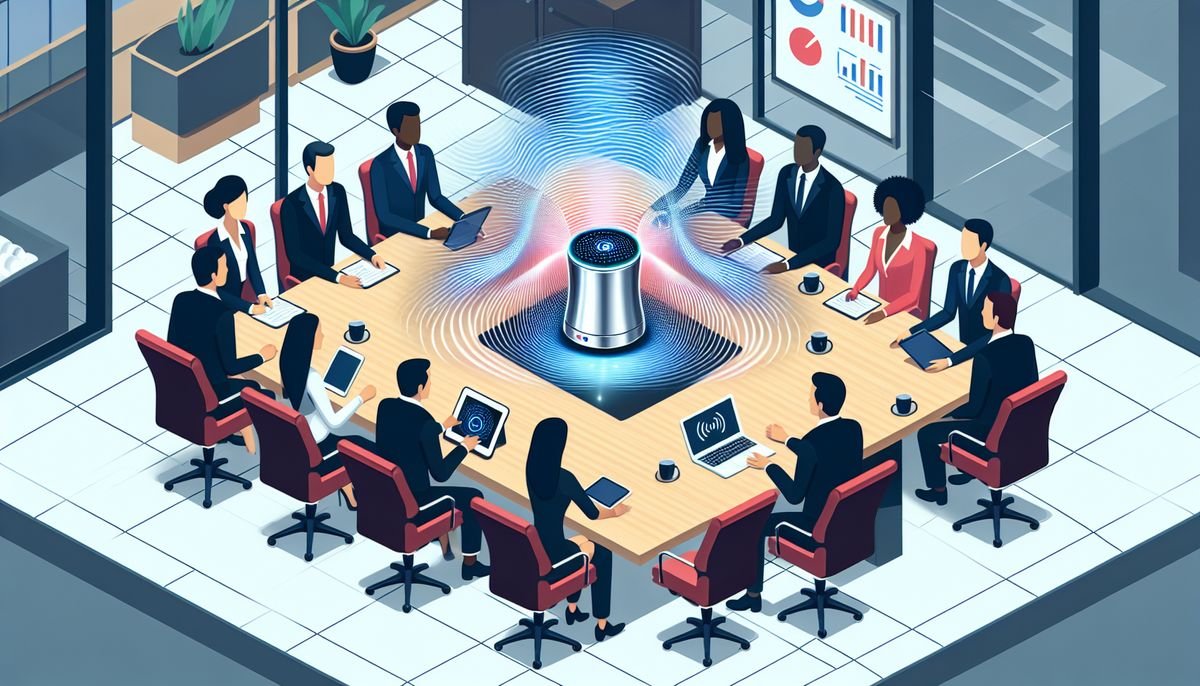In the rapidly evolving landscape of artificial intelligence, OpenAI’s Whisper emerges as a groundbreaking tool poised to revolutionize business communications. Whisper’s advanced capabilities in processing and understanding human language offer businesses an unprecedented opportunity to enhance efficiency and streamline workflows. This article delves into the practical applications of Whisper, navigating its challenges, and ensuring its ethical use to maximize the potential benefits for your business.
Key Takeaways
- OpenAI’s Whisper can significantly improve business communication by providing accurate transcriptions and translations, facilitating clear and efficient interactions across different languages and dialects.
- Integrating Whisper into business workflows requires careful consideration of ethical guidelines and the establishment of boundaries to prevent misuse and ensure AI operates within intended parameters.
- Businesses must stay informed about AI advancements and be prepared to adapt their strategies, ensuring they leverage the latest technologies while mitigating associated risks.
Harnessing OpenAI’s Whisper for Enhanced Business Communication
Understanding Whisper’s Role in Modern AI
OpenAI’s Whisper has emerged as a pivotal tool in the realm of artificial intelligence, particularly in the sphere of business communication. Whisper’s proficiency in deciphering context and nuance in speech is especially advantageous for interpreting complex command structures, which is essential for businesses aiming to streamline their operations with AI assistance. Whisper’s role extends beyond mere transcription; it acts as a bridge between human interaction and machine comprehension, enabling devices to understand and execute commands with remarkable accuracy.
The integration of Whisper into business workflows is not just about efficiency; it’s about redefining the way we interact with technology. As AI continues to evolve, the importance of clear and effective communication between humans and machines becomes increasingly critical. Whisper serves as a testament to the advancements in AI, showcasing the potential to enhance our daily business operations in ways previously unimagined.
Whisper’s role is not limited to functionality; it also raises important ethical considerations. As businesses adopt Whisper and similar AI technologies, they must navigate the delicate balance between leveraging AI’s capabilities and maintaining responsible use. The ethical use of AI in communication is a topic that requires ongoing dialogue and careful consideration to ensure that the technology serves to benefit society as a whole.
Integrating Whisper into Your Business Workflow
In the rapidly evolving landscape of business communication, OpenAI’s Whisper has emerged as a pivotal tool for enhancing efficiency and accuracy. By leveraging Whisper’s advanced speech-to-text capabilities, businesses can transcribe meetings, dictate emails, and create documentation with unprecedented speed and precision.
To effectively integrate Whisper into your business workflow, consider the following steps:
- Assess your communication needs to determine where Whisper can have the most impact.
- Set up the necessary infrastructure, ensuring compatibility with your existing systems.
- Train your team on how to use Whisper, focusing on best practices for clear audio capture.
- Establish a protocol for reviewing and editing transcriptions to maintain quality.
It’s essential to recognize that while Whisper can significantly streamline communication, it is not a replacement for human judgment and oversight. As an example, the recent trend of connecting various OpenAI tools, such as GPT-3, DALL-E, and Whisper, through platforms like Zapier, highlights the importance of integrating AI tools in a way that complements human skills and enhances overall workflow efficiency.
By thoughtfully incorporating Whisper into your business processes, you can unlock new levels of productivity and ensure that your team stays ahead in a competitive market.
Ensuring Ethical Use of AI in Communication
The ethical landscape of AI in business communications is complex and multifaceted. Ensuring the alignment of AI systems with human values is a critical challenge, as it involves not only technical precision but also a consensus on whose values are being represented. The potential for AI to disrupt the information ecosystem with misinformation is a pressing concern, especially considering the capabilities of AI to generate convincing fake news.
- The ethical use of AI requires rigorous oversight to prevent misuse.
- Transparency in AI operations can help mitigate risks associated with AI-generated content.
- Continuous dialogue among stakeholders is essential to navigate the evolving ethical considerations.
The ethical integration of AI into business communication demands a proactive approach to align AI behavior with societal norms and values.
The conversation around AI ethics is not just theoretical; it has practical implications for the future of humanity. The debate on whether AI should adhere to our moral frameworks is ongoing, with some experts suggesting an 80-90% chance that AI could pose a significant risk to humanity within the decade. As businesses adopt tools like OpenAI’s Whisper, they must remain vigilant in their ethical responsibilities to ensure that AI enhances, rather than compromises, the integrity of communication.
Navigating the Challenges of AI in Business Environments
Mitigating Risks of Misinformation and AI Misuse
In the realm of business, the potential for AI to inadvertently or maliciously spread misinformation is a pressing concern. Businesses must be vigilant in establishing protocols to prevent AI from being exploited for the dissemination of false information. This is particularly crucial as AI technologies like OpenAI’s Whisper become integral to business communications, where accuracy and trust are paramount.
To address these challenges, businesses can adopt a multi-faceted approach:
- Developing robust AI governance frameworks to ensure accountability and transparency.
- Training AI systems with diverse, high-quality datasets to reduce biases and inaccuracies.
- Implementing regular audits of AI-generated content to catch and correct errors promptly.
It is essential for businesses to not only focus on the technological aspects but also to foster an organizational culture that prioritizes ethical AI use and critical thinking among employees.
Recent initiatives by state officials highlight the proactive steps being taken to mitigate AI risks. In December 2023, a significant installment focused on identifying and tackling AI risks, from misinformation to data privacy concerns, showcasing the importance of leadership in navigating the AI landscape.
Setting Boundaries: AI Limitations and Human Oversight
In the rapidly evolving landscape of artificial intelligence, embracing the limitations of AI is crucial for maintaining a safe and productive workplace. While AI systems like OpenAI’s Whisper can significantly enhance business communications, they must be deployed with a clear understanding of their boundaries and the necessity for human oversight.
Human supervision of AI is not just about monitoring outputs but also involves reskilling and upskilling workers to ensure they can effectively manage and collaborate with AI systems. This dual approach is essential for harnessing the full potential of AI while safeguarding against unintended consequences.
The alignment of AI systems with human values is a complex and critical task. It requires meticulous design and constant vigilance to ensure that AI operates within the ethical and practical frameworks established by its human stewards.
As we integrate AI into more aspects of business, it’s imperative to consider the potential risks and ethical dilemmas it presents. From the spread of misinformation to the misuse by malicious actors, the challenges are significant. Setting boundaries and maintaining human oversight are key to navigating these challenges effectively.
Preparing for the Future: Adapting to AI Advancements
As businesses continue to integrate AI technologies like OpenAI’s Whisper, it’s crucial to stay ahead of the curve in understanding and adapting to AI advancements. The rapid evolution of AI capabilities presents both opportunities and challenges for business communication.
One of the most pressing concerns is the potential for AI to be misused, intentionally or not, leading to misinformation or even harm. For instance, AI’s ability to generate convincing fake news or manipulate information can have serious implications for businesses and society at large. It’s essential for businesses to establish robust protocols to prevent such scenarios.
To effectively prepare for the future, businesses should consider the following steps:
- Continuously monitor AI developments and assess their potential impact on business operations.
- Invest in employee training to ensure a workforce that is knowledgeable about AI capabilities and risks.
- Develop ethical guidelines that govern the use of AI within the company.
- Engage with AI experts and policymakers to contribute to the broader conversation on AI governance.
By proactively addressing these areas, businesses can mitigate risks and harness the full potential of AI to enhance communication and drive innovation.
Conclusion
As we navigate the complexities and potential perils of artificial intelligence, tools like OpenAI’s Whisper offer a glimpse into the transformative power of AI in enhancing business communications. Whisper’s ability to process and transcribe audio with remarkable accuracy is not just a testament to the advancements in machine learning, but also a practical asset for businesses seeking to streamline their operations. By integrating Whisper into their communication strategies, companies can unlock new efficiencies, improve accessibility, and ensure that no valuable insight is lost in translation. However, as we embrace these innovations, it is imperative to approach AI with caution, crafting clear guidelines and ethical considerations to steer its development and application. The future of AI in business is bright, but it is up to us to illuminate the path responsibly, ensuring that technology augments human potential without compromising our values or safety.
Frequently Asked Questions
How does OpenAI’s Whisper contribute to business communication?
OpenAI’s Whisper is a powerful speech-to-text technology that enhances business communication by providing accurate transcription services. It can convert spoken language into written text in real-time, enabling efficient documentation, easier accessibility for global teams, and streamlined workflows.
What are the ethical considerations when integrating Whisper into my business?
When integrating Whisper into your business, it’s important to consider privacy and consent, ensuring that all parties are aware of the AI’s use. Additionally, maintaining transparency about the AI’s role and addressing biases in language processing are key ethical considerations.
Can Whisper handle different accents and dialects effectively?
Whisper is designed to handle a variety of accents and dialects, leveraging large datasets and machine learning to improve its understanding over time. However, its performance may vary, and it’s recommended to provide clear audio inputs for best results.



